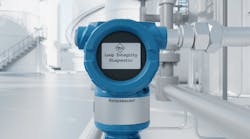Often, it’s better to know what you’re dealing with before it becomes a problem. Rosemount 3051 Pressure Transmitters feature an increasingly broad range of diagnostics designed to head off both instrumentation-related issues and broader process problems before they cause production interruptions. Loop integrity, plugged line alerts, onboard logs and other process alerts are among those diagnostic capabilities of the transmitters.
“There are a lot of diagnostics built into the latest devices and they are continuously running in the background, checking the transmitter’s health and making sure that the electronics, the sensor module, and all of the integral parts are working properly,” says Jacob Sharockman, product manager at Emerson.
While there is a plethora of diagnostics capabilities built into the Rosemount 3051 Pressure Transmitter—both previously existing and newly added—two of the features that have received extensive updates are loop integrity and plugged line alerts.
Ensuring loop integrity
Electrical loops are frequently subjected to a variety of environmental and human stresses that can put the reliability of a 4-20 mA control loop at risk. The result is the control system receiving incorrect measurements, potentially leading to safety- and quality-compromising decisions. The loop integrity diagnostic in the Rosemount 3051 Pressure Transmitter monitors the electrical loop to detect issues that affect the communication signal and will alert users to issues such as corrosion, water in the housing, or an unstable power supply.
When the loop integrity diagnostic is enabled, the transmitter determines the baseline conditions of the electrical loop by capturing resistance and power supply values. Using Ohm’s Law, the transmitter develops a relationship between terminal voltage and output current. This relationship is based on the premise that, when a transmitter is installed, the electrical loop has a baseline characteristic that reflects proper installation, which allows the transmitter to monitor if loop characteristics degrade or change over time. Users can specify a preferred tolerance range for changes in the voltage. If the voltage range falls outside of the set window, the loop integrity alert will trigger and suggest potential sources causing deviations so they can be addressed. “They could be caused by issues like corroded wires or corroded terminals, or water in the housing,” Sharockman says.
The most important aspect of the loop integrity diagnostic is the ability to assure users that the control system is getting the correct information. Sharockman says this diagnostic feature has resonated with Emerson’s users. “A loop check is something that every user does when they install one of our pressure transmitters to make sure the transmitter milliamp output is being correctly seen in the control system” he says. With the loop integrity diagnostic, the device will be able to notify you if anything changes in the loop over time that would affect the reading the control system is receiving just like if you were continuously performing a loop check over the life of the device.
Megan Wiens, product manager at Emerson, points out that the loop integrity diagnostic has been improved from previous Rosemount 3051 Pressure Transmitter models so that it is simple to set up. It only takes a few steps and a couple of seconds but provides significant peace of mind. It’s also easier to interpret the information on the transmitters enhanced graphical display. With the new display, she says, users get a full description of the alert that is detected.
Keeping lines open
Another major update to the diagnostics capabilities of the Rosemount 3051 Pressure Transmitter is the plugged line diagnostic, which is focused on the transmitter’s ability to read the process. In processing industries, impulse lines can be susceptible to plugging from material buildup or freezing, which isolates the transmitter from the process. Plugging may be difficult to detect because it may look like the measurement point is operating normally, but the transmitter is unable to see and therefore respond to process changes. The transmitter continuously monitors for plugged lines and alerts users to abnormal conditions that can lead to unsafe conditions or process quality issues.
To be able to see a plugged line alert directly on the display is an improvement that brings more clarity for the user. Wiens says it is a nice improvement that Emerson was able to make to the transmitters.
Sharockman adds that the ideas of loop integrity and plugged line alerts are aimed at giving operators and technicians the most accurate information to make the best decisions possible for their process operation. Wiens agrees saying, “The real value in both loop integrity and plugged line diagnostics are that the information provided by the transmitter is truly what is going on in your process, and that is important because some failure modes may still look like typical operation.”
Logs and alerts
Emerson has expanded the logging capabilities on the Rosemount 3051 Pressure Transmitter quite significantly.
It has introduced a diagnostic log to the transmitter that can store up to 100 diagnostic events, including basic diagnostics and other diagnostics options beyond loop integrity or plugged lines.
“The diagnostic log can be a really helpful tool to use when troubleshooting the device, or just simply for maintenance purposes to understand what conditions your device has been in,” Wiens says.
She says the device includes not only the diagnostics log, but also a calibration log. In addition, it features several process alerts, which have been expanded to offer new variables. For example, the Rosemount 3051 Pressure Transmitter can alert for pressure, module temperature and other process extremes. In addition to pressure and module temperature, flow, level, volume, or totalized flow process variables are now available for monitoring within the process alert.





